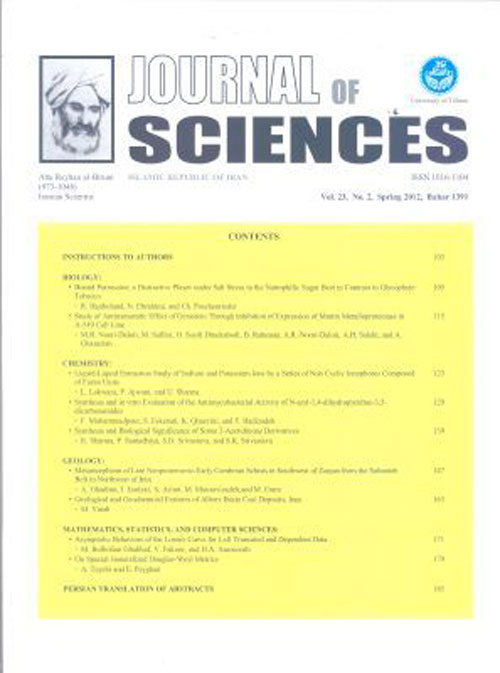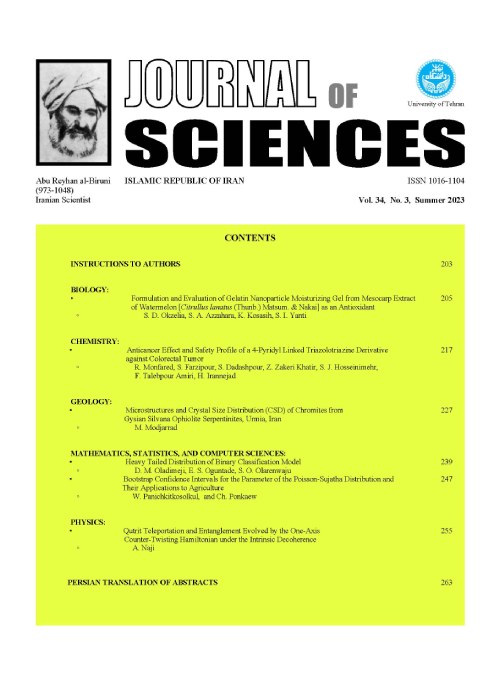فهرست مطالب

Journal of Sciences, Islamic Republic of Iran
Volume:33 Issue: 2, Spring 2022
- تاریخ انتشار: 1401/06/20
- تعداد عناوین: 6
-
-
Pages 105-116Copper (Cu) is an essential micronutrient for higher plants and is required for cell redox homeostasis, free radical scavenging, function of electron transport chains and cell wall lignification. Copper deficiency is a widespread nutritional disorder in plants and its adequate supply is necessary for an optimum crop production. In order to evaluate the efficacy of nano tetraammine copper (II) sulfate complex ([Cu(NH3)4]SO4) (NCu) in the meeting of plants Cu requirement, Cu-sufficient (+Cu) and Cu-deficient (–Cu) tobacco (Ncotiana rustica L.) plants were treated with 0.5 µM NCu complex through leaves. The shoot and root biomass and photosynthesis of –Cu plants were restored by foliar application of NCu complex, while in the +Cu plants the shoot biomass was repressed likely due to a supra optimal Cu level. Foliar application of NCu complex restored almost completely the activity of Cu-containing enzymes, superoxide dismutase, polyphenol oxidase and diamine oxidase. Iron (Fe) homeostasis was also significantly influenced by both Cu starvation and foliar application as could be confirmed by Fe concentration data and activity of Fe-enzymes, peroxidase and polyamine oxidase. The activity of phenylalanine ammonia lyase and the levels of phenolics and lignin were markedly decreased in the –Cu plants. These parameters, however, were completely restored or even exceeded that of the +Cu plants upon foliar application. Our results suggest that, foliar application of NCu is a feasible method for a rapid and efficient compensation of Cu deficiency symptoms due to a high penetration ability and a sufficient retranslocation of applied Cu in the phloem.Keywords: Cu-containing enzymes, Phenolics, Lignin, Foliar Application, Nano Complex
-
Pages 117-124This study aimed to investigate the effects of Plantago ovata plant extract on the expression of beta-lactamase-producing genes in multidrug-resistant (MDR) K. pneumoniae isolates. This study was conducted on 50 samples of COVID-19 patients admitted to the intensive care unit of respiratory hospitals. K. pneumoniae isolates were identified using standard biochemical tests, culturing, and Gram staining. The antibiotic susceptibility profile of isolates was determined using the micro broth dilution method. Then, P. ovata extract was prepared and its effects on the expression of MDR K. pneumoniae genes were evaluated. Totally, 50 samples were collected from 50 patients (25 males and 25 females, 58 ± 2.2 years of age) with COVID-19 infection. Thirty K. pneumoniae strains, 4 K. oxytoca strains, 2 K. mobilis strains, and 2 strains of K. rhinoscleromatis were isolated here. Gentamicin and chloramphenicol did not affect the strains and piperacillin/tazobactam was the most effective antibiotic. CTX-M15, OXA-48, and OXA-181 genes were detected in 29 (96.6%), one (1.66%), and one (1.66%) K. pneumoniae strains, respectively. The minimum inhibitory concentration of P. Ovata was 3.125 μg/ml for the isolated bacteria, and the extract significantly downregulated OXA-48 and OXA-181 genes (p<0.005, CI=95%). P. ovata extract showed antibacterial effects on MDR species of clinically isolated K. pneomoniae. Downregulation of beta-lactamase enzyme-producing genes can be considered as the possible mechanism action of antibacterial effects of the plant.Keywords: P. ovata, K. pneomoniae, Beta-lactamase, Antibacterial
-
Pages 125-132A 2,4-D-free protocol for indirect asexual embryogenesis from root explants of date palm cv. Barhi has been established. Different mixtures and concentrations of plant hormones were applied for direct root induction from juvenile leaf explants of the apical meristem in the offshoot shoot terminal. The highest percentage of induced roots was obtained on the Murashige and Skoog (MS) medium complemented with NAA (1 mg L-1), NOA (3 mg L-1), IBA (1 mg L-1), and 2ip (0.1 mg L-1). The highest percentage of induced callus, both embryogenic and non-embryogenic callus, was achieved from in vitro-induced roots cultured on the Murashige and Skoog medium complemented with BAP (2 mg L-1) and NAA (0.1 mg L-1). The highest number of somatic embryos was acquired on the Murashige and Skoog medium complemented with BAP (2 mg L-1) and NAA (0.1 mg L-1). Successful rooting of date palm plantlets achieved on the PGR-free ½ MS medium following three weeks. The endurance value of rooted plantlets obtained from indirect somatic embryogenesis pathway, was 70.32%. The developed protocol would be applicable for rapid and efficient mass propagation of elite cultivars of date palm with less risk of generating genetic instability.Keywords: Phoenix dactylifera L, Direct organogenesis, Micropropagation, Somatic embryos, plant growth regulator
-
Pages 133-138Silver nanoparticles (AgNPs) are well-known nanomaterials that have been mainly used as antimicrobial agents Hundreds of chemical or biological methods have been reported and described for the preparation of AgNPs in water so far. Aqueous colloids of AgNPs normally have a limited capacity to safely change to the concentrated form using conventional methods such as different evaporation methods. Organic solvents which could be easily evaporated using conventional evaporation vacuum methods are good candidates for the preparation of highly concentrated AgNPs formulations or dried concentrates. In this study, we used a previously described biological method for preparing AgNPs in an acetone-water solvent mixture. The nanoparticles were synthesized using culture supernatant of Klebsiella pneumonia in the above organic solvent mixture supplemented with polyethylene glycol 6000 in a bright condition and subsequently dried by a conventional evaporation method. In the next step, dried residues were re-dispersed in water under ultra-sound treatment and characterized with different instrumentation methods. The results showed spherical AgNPs with a size range of ≤ 200 nm. This is the first report on the biological synthesis of AgNPs in an organic solvent mixture which could be easily converted to a dried form. This dried AgNPs concentrate is a good candidate for the preparation of very thick formulations of AgNPs such as solid or semi-solid pastes.Keywords: Silver nanoparticles, Organic solvents, Biological synthesis, Klebsiella pneumonia, Dry concentrate
-
Pages 139-148In modeling the variables related to each other, regression models are usually used assuming that the response variable is Normal. But in problems dealing with data such as the rate or ratio of an event distributed in the (0,1) interval, these models may provide out-of-range predictions for the response variable. In addition rate or ratio data are oftem asymmetrically distributed, and the use of symmetric distributions leads to invalid results. In such cases, the Beta regression model is used, in which the distribution of the response variable is in the Beta family. Bayesian analysis of these models generally requires the calculation of multiple integrals. The use of MCMC algorithms sometimes encounters long computation times and divergence. This work presents approximate methods for obtaining posterior distributions for Bayesian analysis of Beta regression models. Then the Integrated Nested Laplace Approximation will be offered for getting the posterior distributions in the Bayesian analysis of these models. Moreover, these models' application is illustrated on a real data set.Keywords: Beta regression models, Integrated nested Laplace, Approximation Bayesian inference
-
Pages 149-156Tuberculosis (TB) remains one of the 21st century's crucial public health problems. Today, it is the second leading cause of death from a single infectious disease agent. Spatial information on health-related diseases like TB is not well documented in Nigeria. The study of Spatial Distribution of TB in Niger State is necessitated for broad and more comprehensive coverage of TB cases within the State. As such, there is a need to carry out a spatial auto-correlation analysis of the entire 25 Local Government Areas (LGAs) of the State to explore the epidemiological data, distribution, and pattern of infection from 2016 to 2020. This study investigated the spatial auto-correlation structure with the Moran Index, Anselin's local Moran's I, Getis-ord local statistics and kriging interpolation methods. The result of the Analysis of Variance (ANOVA) showed that there was a significant difference in infection patterns between LGAs. This result implied variability in the number of cases across different local governments within the study periods. Although the considerable number of TB-reported instances, the analysis based on Moran's I and global G revealed no clustering pattern in the data. The local indicator of spatial association result showed that the number of cases was random across the LGAs; there were no significant clusters. Kriging interpolation method identified Kontogora, Bosso and Chanchaga LGAs as hotspots of TB cases in Niger State. This study provides information that can assist policymakers in rationally planning targeted interventions to effectively control TB while addressing the underlying socio-economic risk factors in Niger State. This study has shown that despite data limitations, Geostatistical approaches are viable for understanding interpolation patterns.Keywords: Moran's I, Spatial auto-correlation, Global statistic, Kriging, tuberculosis


